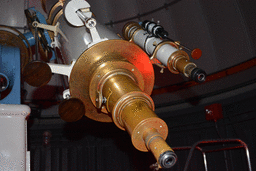

A major refurbishment was carried out in 2003 and a further one in 2018, at which point the old eyepiece table attached to the dome was removed (it kept getting in the way of observing at certain azimuths) and replaced by a movable cupboard, and the clocks on the wall (standard and sidereal) were repaired - they had been broken for decades.
A 7.5-inch Clark was also formerly at the CfA; after many years of disuse in the center of the upper parking lot, it was removed to storage.
 |
 |
| The Clark on the roof of 60 Garden St Bldg B | |
 The Clark in 2015
The Clark in 2015
 The user end
The user end
The telescope is very easy to use, the main limitation being the brightness of the Greater Boston night sky. The excellent Clark optics allow one to easily make out the Cassini Division in Saturn's rings. Globular clusters are also good targets. On a good night the Ring Nebula is an easy find, but lower surface brightness objects such as M33 are challenging at best (i.e. I've never managed it).
One of my most memorable observations using the Clark was with Brian Marsden on 1994 Jul 16, when we saw the debris clouds from the impact on Jupiter of Comet Shoemaker-Levy 9, just a few hours after the event. Here is a lovely sketch taken by Stephen James O'Meara a few weeks later, based on his observations with the Clark.
In addition to public open nights and student training, the telescope is available for use by Center for Astrophysics staff. A short training lesson is required; apply to the current Clark Trainer (currently me, Jonathan McDowell). See my user instruction checklist . After training, the user's CfA access card is enabled for the telescope door by the CfA Computation Facility staff.
 |
 |
| Upper inscription reads "The Alvan Clark & Sons Corp'n"; Lower: "Cambridgeport, MA 1912" | |